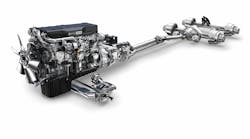A new integrated powertrain package – linking together a proprietary engine, automated transmission and axles – will be rolled out by the Detroit division of Daimler Trucks North America starting in January next year.
Initially available only for the Freightliner Cascadia Evolution Class 8 tractor and then later in 2015 for the Western Star 5700, Detroit’s new integrated powertrain combines a DD15 engine with a new “downspeed” rating of 400 hp and 1750 lb.-ft. of torque with the company’s DT12 automated transmission and axle products.
Brad Williamson, DTNA’s manager of engine and component marketing, told Fleet Owner by phone that two rear axle options will be offered with Detroit’s new integrated powertrain: a 6x2 rear axle configuration with a 2.28 ration and a non-driven tag axle on the tandem, reducing total weight by almost 400 lbs., along with a new 2.41 ratio 6x4 rear axle set up.
“To this point, we’ve offered each piece of powertrain separately; now we’re combining them into one package to maximize fuel economy, along with other benefits,” he said.
For example, Williamson pointed that by “tuning” transmission electronics and axle rations precisely to the DD15 engine calibrations “downspeeding” can now occur efficiently – meaning more engine torque can be made available at slower engine speeds of roughly 975 revolutions per minute (rpm) versus 1,050 rpm.“This is something [downspeeding] that our competitors have offered for a while and now we’re able to offer it,” he said. “Basically, it is the ability to provide more torque at slower engine speeds and that helps save on fuel without compromising performance.”
Detroit’s DT12 transmission – equipped with what the company calls Intelligent Powertrain Management (IPM) – is what really will help drive further fuel economy savings, Williamson noted. By using pre-loaded terrain maps and global position system [GPS] location data to literally “see” the route ahead, the DT12 on cruise control can automatically adjust transmission and engine functions to save fuel while ensuring a smoother ride.
“This is something a driver simply cannot do, because they can’t see over the crest of a hill,” Williamson added. “By using pre-loaded maps and GPS, however, the DT12 can – so it will literally ‘know’ it can stay in 11th or 12th gear on a hill because it knows where the top is and how steep the grade is on the other side.”
In his view, the DT12 transmission is the "critical link" between the engine and the axles, and with the addition of the IPM feature, it provides a "seamless solution" that has a direct impact on fuel savings.
Williamson stressed that the other big benefit to DTNA customers from an integrated powertrain is that since all the components – engine, transmission, and axles – are built by one company, in this case Detroit, more detailed information can be shared between them and they can all be serviced at one location.
“That’s the ‘secret sauce’ if you will: we share all the available information between the components because, as I like to say, ‘they all speak Detroit,’” he explained. “We can also offer ‘one stop shop’ service as everything – the truck, engine, transmission, and axles – is ours. No more going over here to deal with an engine issue, over there for transmission service, with separate stops for axle work and truck maintenance thrown in as well.”
“We know exactly what our customers want: Leading technologies integrated from one source that allows the customer to easily implement into their business model and improve uptime, safety and efficiency,” noted David Hames, DTNA’s general manager of marketing and strategy, in a statement.
“We’re able accomplish the level of performance and efficiency the [new] integrated powertrain provides by designing, engineering, testing and manufacturing everything under one roof,” he added. “Every individual product was studied to make certain they were specifically tuned to work together to deliver maximum efficiency.”
Williamson also pointed out that Detroit is going to forgo the traditional “printed brochure” route and instead provide details on its new integrated powertrain through a new “Demand Detroit App” for both Android and iOS devices, which will be activated sometime in early June.




